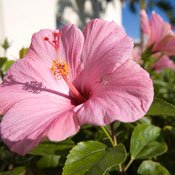Are you limited to an apartment windowsill or small balcony but still want to grow organic food to liven up your diet? Try edible flowers.
Usually only seen in high-end gourmet restaurants to garnish salads or brighten a plate, edible flowers are easy to grow, bloom all summer long and come in a variety of colors, shapes and flavors.
Here are a few listed in the Johnny's Selected Seeds catalog (johnnyseeds.com) and widely available elsewhere:
• Nasturtiums (Nasturtium officinale) are probably the best-known edible flowers—you can eat the flowers when they are fully open and eat the leaves, too. They come in yellows, oranges and reds.
• Calendulas (Calendula offinalis) are edible when the flowers are fully open. They come in various shades of yellow, some with darker tinges on the edges.
• Bachelor's buttons (Centaurea cyanus) or classic cornflowers come in a variety of colors that produce abundantly. They can make successive sowings to bloom all summer.
• Hibiscus (Hibiscus moscheutos) has a nice nutty flavor. Hummingbirds love them, too.
• Hollyhocks (Alcea ficifolia) are large 3-inch to 4-inch flowers on long stems that range in color from cream white to yellow to pink and deep maroon.
• Hyacinth Bean (Dolichos lablab) also make nice cut flowers and come in shades of purple.
• Ornamental, cutflower kales (Brassica oleracea) are cool-weather plants that you can plant in the fall and grow into the cold weather. These are colorful, leaf-type cabbages that are edible.
Of course, if your roses have not been treated with chemicals, they are edible, too. My beautiful wife, Annette, puts rose petals in the teas she makes. You can boil them in water and add lemon juice and sugar or honey for a stand-alone tea, put them in an omelet, or use them as a garnish (they are really pretty in yogurt!).
Clip this article out and take it to your local garden supply store. Buy organic or heirloom seed varieties to ensure they aren't genetically modified "frankenseeds."
Remember: You want to grow organically, so don't use chemical pesticides, etc. Pollinators like butterflies and honeybees like edible flowers as well, so let's help keep them healthy, too!
Jim PathFinder Ewing is the author of five books on energy medicine and eco-spirituality (Findhorn Press) published in English, French, German, Russian and Japanese. His next book, to be published in the fall, is titled "Conscious Food: Sustainable Growth, Spiritual Eating." Find Jim on Facebook, follow him @edibleprayers or visit http://www.blueskywaters.com.



Comments
Use the comment form below to begin a discussion about this content.
comments powered by Disqus